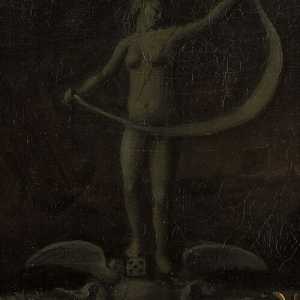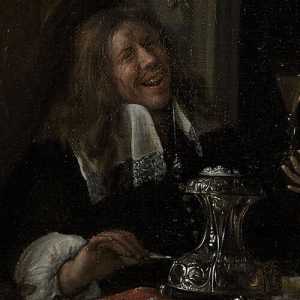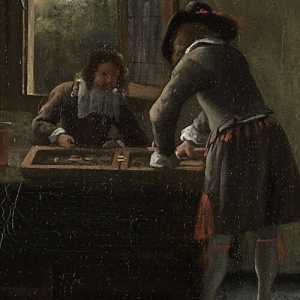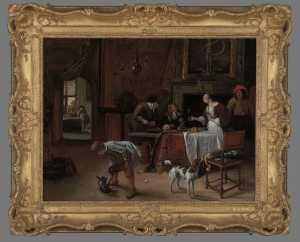This apparently cosy domestic scene delivers a strong moralising message. A tablet on the mantlepiece bears the phrase: 'Easy come, easy go', which means that in gambling any winnings are soon lost again. It is a warning against betting on backgammon, which is being played in the room beyond.

Specifications
| Title | 'Easy Come, Easy Go' |
|---|---|
| Material and technique | Oil on canvas |
| Object type |
Painting
> Painting
> Two-dimensional object
> Art object
|
| Location | This object is in storage |
| Dimensions |
Width 104 cm Height 79 cm |
|---|---|
| Artists |
Painter:
Jan Havicksz. Steen
|
| Accession number | 2527 (OK) |
| Credits | Acquired with the collection of D.G. van Beuningen, 1958 |
| Department | Old Masters |
| Acquisition date | 1958 |
| Creation date | in 1661 |
| Collector | Collector / D.G. van Beuningen |
| Internal exhibitions |
The Collection Enriched (2011) De collectie als tijdmachine (2017) |
| External exhibitions |
De verbeelding van de Nederlandse spreekwoorden (2006) Boijmans bij de Buren - Samensmeden, Meesters in zilver (2019) |
| Research |
Show research Alma |
| Material | |
| Object | |
| Geographical origin | Northern Netherlands > The Netherlands > Western Europe > Europe |
Do you have corrections or additional information about this work? Please, send us a message
All about the artist
Jan Havicksz. Steen
Leiden 1626 - Leiden 1679
Jan Steen is known for his humorous depictions of the everyday life of farmers and the middle-classes in 17th-century Holland. He worked in The Hague, Haarlem,...
Bekijk het volledige profiel



























